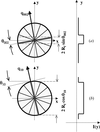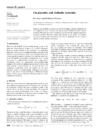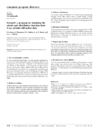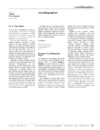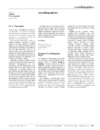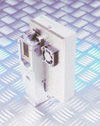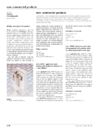issue contents
August 2001 issue

Cover illustration: Diffuse scattering around a 200 Bragg peak from a Cu-Ti single crystal (the intensities are in ln scale, the plane is (001), with the [100] direction horizontal, and the Bragg peak is masked by the blue beam stop). Courtesy of O. Lyon, C. Servant & J. P. Simon [J. Appl. Cryst. (2000), 33, 928-937].
research papers
Free 

The method, process and results of the IUCr-CPD round robin on quantitative phase analysis are summarized. Results are presented in the context of instrumental and analytical strategies applied by the participants.
Grazing-incidence scattering geometry is applied to determine residual stresses at different depths below the sample surface. A new method of data treatment leads to reference-free stress measurements for anisotropic samples.
A procedure is presented for modelling the axial divergence aberration profile, taking into account all second-order and end effects of the diffractometer system. It is shown that relatively simple calculations, which could be introduced into Rietveld refinement programs, allow the instrument line profile to be modelled accurately at low and high scattering angles.
Orientation distributions of garnet and omphacite in eclogite from the ultra-high pressure Dabie Shan belt in east-central China were determined from time-of-flight neutron diffraction data with the Rietveld method and results are compared with EBSP measurements. Cubic garnet has a random orientation distribution, while monoclinic omphacite displays a sharp texture, with [001] parallel to the lineation direction.
The molecular-weight and unit-cell capabilities of neutron protein crystallography are tested via the example of cubic concanavalin A. Analyses of neutron quasi-Laue data from this crystal suggest improvements to the apparatus options for data collection.
The analytical formalism describing the diffraction peak intensity profile I(y), the shift of the centre of gravity 〈y〉 and the profile variation W is developed for Bragg–Brentano powder diffractometers working with linear position-sensitive detectors.
The conditions required to achieve stoichiometric and homogeneous amorphous hydrogenated silicon carbide thin films deposited by plasma enhanced chemical vapor deposition are described.
The new technique of scanning microbeam X-ray diffraction is used to obtain information about the cross-sectional crystallographic texture of single carbon fibres. Modelling of the diffraction data allows a quantitative description of the radial folded texture in a mesophase pitch-based fibre.
Formulae are given for the planarity and similarity restraints' target functions and their first and second derivatives with respect to the atomic coordinates.
Single crystals of Cu–41.5 at.% Ni–16 at.% Fe have been studied by small-angle and large-angle X-ray scattering in order to determine the displacements induced by the disc-like precipitates formed during decomposition. The SAXS patterns gave information on the size and the organization of the precipitates, while the scattering near Bragg peaks allows a determination of the distortions of the lattice created by these precipitates.
The thermal diffuse scattering (TDS) correction developed by Popa & Willis [Acta Cryst. (1997), A53, 537–545] for single-crystal pulsed neutron diffraction is examined via a series of experimental data sets collected at the spallation neutron source IPNS and by comparison with benchmark gamma-ray data. In all examples that have been considered, application of the TDS correction led to appreciable changes in the thermal parameters and has increased the information content of the data at hand by enabling recognition of the achieved degree of accuracy from the pattern of comparative results.
Clear multi-dimensional chord distributions from nanocomposites can be computed by application of spatial frequency filters to small-angle scattering patterns.
The ability of asymmetric Laue crystals to focus high-energy X-rays sagittally is demonstrated. The anticlastic bending of a Laue crystal facilitates the use of inverse-Cauchois geometry in the meridional plane.
A new algorithm, called the term selection algorithm (TSA), is derived to treat small-angle scattering data by fitting models to the scattering intensity using weighted Hermite polynomials.
computer programs
Integration of control and data reduction for simultaneous small- and wide-angle X-ray scattering (SAXS and WAXS) measurements allows the very high rates of incoming data to be handled. Reduced results are available directly to the users, with a choice of a number of standard formats for further analysis.
The phasing procedure of SIR2000 has been modified to improve efficiency and offer a wider applicability range.
A program, MASSHA, for three-dimensional rendering and rigid-body refinement is presented. The program allows display and manipulation of high-resolution atomic structures and low-resolution models, represented as smooth envelopes or ensembles of beads.
laboratory notes
The pH and conductivity of each of the 50 solutions in each of two lots of the Crystal Screen kit have been measured before and after incubation in a sealed chamber for six weeks. The results indicate that the measured pH of the solutions in the Crystal Screen is reproducible between different kits but that the measured value is not always related to the buffer system.
computer program abstracts
PowderV2 is a suite of applications designed to ease the treatment of X-ray powder diffraction data. It is mainly dedicated to powder diffraction from sealed X-ray sources but has several facilities for the treatment of energy-dispersive X-ray data and constant-wavelength neutron diffraction data.
The program PDFgetX, for obtaining the PDF from X-ray powder diffraction data, is described.
crystallographers
Free 

Free 

new commercial products
Free 

Free 

Free 



 journal menu
journal menu

















